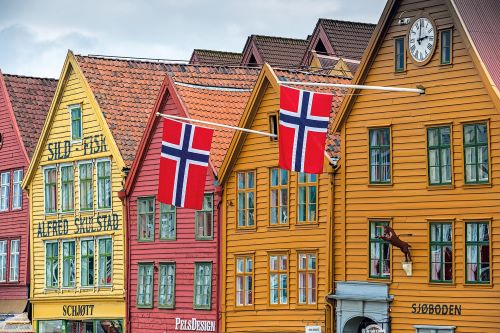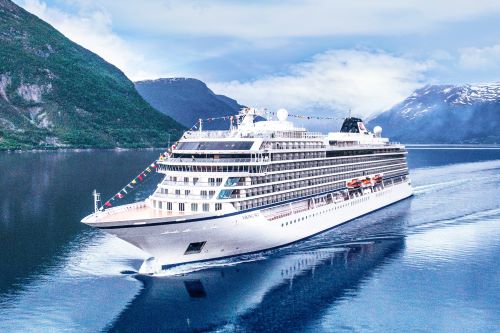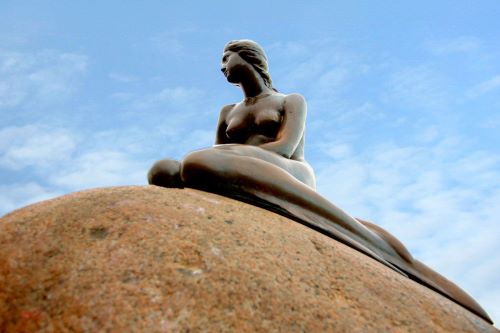Icons of the Viking Age
with Viking
- Bergen to Copenhagen
- Complimentary shore excursion at every port of call
- Enrichment lectures & destination performances
- Spring Sale - Companion flies for free, plus RAC Members save $300^
A captivating voyage of discovery



Circumnavigate the Baltic Sea as you sail through the homelands of the Vikings. Explore the deep-rooted cultural ties of Scandinavia, calling at iconic capitals in Norway, Sweden and Denmark. Sail the picturesque Åland Islands, an archipelago of 6,700 isles. Immerse yourself in the customs, traditions and fascinating history of the Baltic states, home to UNESCO World Heritage Sites, including the old town of Tallinn and the historic center of Riga.
The Viking difference
When most cruise lines are building bigger ships, Viking Cruises provides a thoughtful, authentic and well-designed small ship experience that brings you closer to the world’s cultures. The ‘Viking difference’ is used to identify what sets them apart from other cruise lines, all the things that Viking doesn't offer — because Viking's aim is to provide more of what you really need and less of what you don’t.
No casinos | No charge for alternative restaurants | No smoking | No children under 18 | No charge for Wi-Fi | No waiting in lines | No umbrella drinks | No charge for use of self-service laundry | No formal nights, butlers, or white gloves | No photographers | No entrance fee for The Spa | No nickel-and-diming | No art auctions | No spa sales pressure | No charge for beer & wine with lunch & dinner | No inside staterooms
Viking inclusive value
At Viking you should not have to open your wallet every time you want a cup of coffee, a glass of wine or an excursion ashore. Viking's goal is to provide you with great value, so the cruises are designed to give you more for your money, with a cruise fare that includes everything that you need — from meals and beverages to shore excursions and Wi-Fi.
Applicable across all Viking river, ocean and expedition cruises
- One complimentary shore excursion at every port of call
- Enrichment lectures & destination performances
- Unlimited free Wi-Fi
- Beer, wine & soft drink served with onboard lunches & dinners
- 24-hour access to specialty coffees, teas & bottled water
- All port taxes & fees
- Airport transfers with Viking Air purchase
Day 1: Bergen, Norway
Embark your ship and settle into your stateroom. Bergen is home to the Hanseatic League’s only kontor (trading enclave) still in existence. Bryggen wharf, a row of timbered Hanseatic warehouses along a quaint quay, is a UNESCO World Heritage Site. Narrow wooden walkways are flanked by parallel rows of small, vibrantly painted buildings overlooking the picturesque Vågen Harbor. This is perhaps the most charming district of Bergen and a delight to explore, from its tight-knit community of workshops where artisans sell their wares to its cafés where freshly prepared smørbrød, or open-faced sandwiches, are on the menu.
Day 2: Eidfjord, Norway
The quaint village of Eidfjord is nestled in the heart of one of Norway’s most scenic regions. From the Norwegian Sea, the waters of the expansive Hardangerfjord lead to the smaller Eidfjorden and to this charming mountain hamlet. Eidfjord embodies the Norway of every traveler’s dream, the gateway to Hardangervidda, Europe’s largest mountain plateau of soaring beauty. Wild reindeer roam here, among stunning, treeless moorlands dotted with pools, rivers, streams and the Vøringfossen Waterfall, a 550-foot cascade that plummets into the cavernous Måbødalen Canyon.
Day 3: Haugesund, Norway
The coastal town of Haugesund is considered the birthplace of Norway. The Haraldshaugen Monument marks its unification into one kingdom in 872 and is said to be where the first king of Norway was buried. All the typical characteristics of a seaside Norwegian town are here: rustic timber houses, stunning sea views from the quays and magnificent vistas of fjords from the Steinsfjellet viewpoint. The region’s cultural heritage is inextricably linked to the sea; built on the herring industry, surrounding charming towns have thrived on its success and continue to do so today.
Day 4: Kristiansand, Norway
Kristiansand boasts tidy streets, cozy harbors and small-town charm. The town’s Viking past can be traced in the runestones at the Oddernes Church, built in 1040 and dedicated to St. Olaf, patron saint of Norway. In the 17th century, King Christian IV ordered the Christiansholm Fortress to be built to defend the newly founded city. Today, the edifice is adjacent to an inviting harborside boardwalk. The city’s rich traditions are embodied in the old wooden houses of the Old Town and the stunning neo-Gothic cathedral.
Day 5: Århus, Denmark
Århus, located on Jutland’s eastern coast along its eponymous bay, is Denmark’s second-largest city. One of the country’s oldest cities, with roots dating back to an 8th-century Viking settlement, Århus became a center for trade and prospered during the Middle Ages. Today, it is an eclectic mix of past and present. A bustling port and center for commerce and industry with a modern skyline, it still retains its old-world charms in Den Gamle By, or Old Town, a repository of medieval landmarks, including centuries-old timbered houses and the 13th-century Århus Cathedral.
Day 6: Skagen, Denmark
Skagen is a charming old seaside village nestled amid pristine dunes, picturesque moors and long sand beaches. During the Middle Ages, Skagen was known for its herring catch, and remains a major fishing center today. With the introduction of the railway, a group of impressionist painters discovered the area’s seascapes and soft evening light and journeyed here to found the Skagen Painters; their work is showcased at the small Skagens Museum. The lure of Skagen inspired royalty to visit: King Christian X was so taken with the setting that he built a summer residence here.
Day 7 - 8: Oslo, Norway
Oslo is one of Scandinavia’s most vibrant cities, set on a splendid bay amid stunning fjords and hills. It was founded by a Norseman, King Harald III, and has grown over the centuries around the cherished Akershus Fortress. The city not only has a rich Viking past with its close ties to the sea, it also boasts an impressive artistic heritage. Perhaps its most famous painter is Edvard Munch, whose work The Scream is known the world over. But Gustav Vigeland’s 200 or so sculptures are the most prominent works in the city, on full display throughout Vigeland Park.
Day 9: Gothenburg, Sweden
Gothenburg is a thriving university town of picturesque canals, parks and gardens. Founded under a royal charter of Swedish King Gustavus Adolphus II in 1621, it grew into a major port. In the 18th century, the city prospered from the trade of the Swedish East India Company. That successful period is reflected in the stunning neoclassical stone houses that remain around the city’s canals. Today, a maritime and mercantile past is visible in Gothenburg’s cultural institutions, from the Gothenburg Museum of Art’s paintings to the several museums of navigation and seafaring.
Day 10: Copenhagen, Denmark
Copenhagen charms visitors like a Danish fairy tale. Among the Baltic’s most beautiful cities, it began as a fishing village and boasts more than 850 years of history. It has been an important Scandinavian port since the Viking Age and remains one of Europe’s most enchanting places, thanks to Tivoli Gardens, the world’s second-oldest amusement park, and The Little Mermaid statue sitting in the harbor at Langelinie. Grand palaces also grace the cityscape, including Amalienborg Palace, the royal winter residence, and Rosenborg Castle, home to the Danish Crown Jewels.
Day 11: Karlskrona, Sweden
Founded by Charles XI in 1860, Karlskrona is a fine example of Sweden’s Renaissance-style architecture. The Admiralty Church, built in 1685, is one of the town’s prominent buildings, and the town’s wooden church is the largest in Sweden. Karlskrona’s maritime history can be seen throughout; it is a base for the Swedish Navy and its port was awarded UNESCO world Heritage status in 1998. The Naval Museum showcases the port’s history and its exhibits include a submarine. The nearby Kungsholm Fortress is the world’s oldest fort still in operation today.
Day 12: Gotland (Visby), Sweden
Much of Gotland’s landscape dates to the 6th century, when Vikings dominated the island. More Viking relics have been uncovered here than anywhere else in Sweden, making it a treasure trove of the era. Its strategic location bolstered the local economy when merchant ships of the Hanseatic League docked here for provisions or for trading. Visby grew into the most important city of the League, surpassing even Bergen in significance. Its two miles of defensive walls and 44 watchtowers are among the most remarkably preserved in Europe.
Day 13: Mariehamn, Åland Islands
The Swedish-speaking city of Mariehamn is the capital of Åland, an autonomous territory under Finnish sovereignty. The archipelago spans approximately 6,700 islands and lies halfway between Finland and Sweden. The compact city center sits between two harbors and offers a number of restaurants, cafes and shops. A haven for outdoor activities, it is an ideal location to explore the region by land or by sea. The city’s Viking heritage is a celebrated treasure; each year, Mariehamn hosts the annual Viking Market, one of the largest of its kind in Scandinavia.
Day 14 - 15: Stockholm, Sweden
Elegant Stockholm is nestled where Lake Mälaren’s cobalt waters meet the Baltic. This stunning cultural capital extends over 14 islands linked by 57 graceful bridges. Hailed as one of the world’s cleanest cities, it boasts numerous green parks. The well-preserved 13th-century Gamla Stan, or old town, boasts gabled merchant houses and an array of architectural styles, from the enormous baroque Stockholm Palace to the art nouveau Royal Dramatic Theater. Strandvägen is one of Europe’s loveliest waterfront esplanades and the ideal place to sample some traditional smoked salmon.
Day 16: Tallinn, Estonia
The capital of Estonia, Tallinn is located along the coast of the Baltic Sea. Its well-preserved old town, a UNESCO World Heritage Site, is surrounded by a ring of 17th-century historic fortifications that were built to protect the city from invaders. Inside its walls are the upper town, where the regal castle and the cathedral are located, and the lower town, a maze of merchants’ houses, guilds, churches and public buildings. Some of the most notable landmarks include the Town Hall Square, Alexander Nevsky Cathedral, St. Olaf’s Church and the Kumu Art Museum.
Day 17 - 18: Riga, Latvia
Riga is the largest and most cosmopolitan of the Baltic capitals. Here, medieval meets contemporary in a history and architecture lover’s dream. Vaulting gothic spires and domes of ancient churches dot the narrow cobblestone streets of the UNESCO-listed Old Town, while wide boulevards host striking and ornate examples of stunning Jugendstil Art Nouveau buildings in the new town. Upscale shops mingle with modern art galleries and hip bars, amid innovative, candlelit restaurants, creating a vibrant atmosphere, day or night.
Day 19: Klaipėda, Lithuania
Lithuania’s third-largest city is a historic port on the Curonian coast. Part of the Prussian Kingdom until 1923, when it won its autonomy, Klaipėda is divided by the Danė River, which flows through the city into the Baltic Sea. Along its left bank, the historic old town features cobblestone streets with historic German-style half-timbered houses, street art and a tree-lined promenade filled with cafés. The new town stretches along the Danė’s right bank, past industrial sites and shipyards, amid venues that showcase the city’s art and cultural heritage.
Day 20: Gdańsk, Poland
Gdańsk is widely known as the city of glowing amber and Gothic cathedrals. Its luster harkens back to medieval times when it was one of the most prosperous cities in the Hanseatic League, the mercantile powerhouse of the Baltic. The city’s rich history is on display in the remarkably restored old town, a splendid mix of Gothic, Renaissance and baroque styles—from the royal residence of Green Gate to the 15th-century Artus Court, a merchant’s palace. Traditional Polish pierogies or a glass of Goldwasser, a liqueur created here during the 16th century, round out any visit.
Day 21: Copenhagen, Denmark
Copenhagen’s skyline lies distinctly low to the ground, but some architectural elements soar above all else: the city’s church spires and palace towers. For this reason, the Danish capital is often called the “City of Spires.” Perhaps the most unique, the baroque Church of Our Savior features a spiral stairway that hugs the outside of the steeple. Christian IV’s former stock exchange building boasts a “dragon spire” resembling the entwined tails of four beasts, and the City Hall and Christiansborg Palace strike their own dramatic pose.
Day 22: Copenhagen, Denmark
Bid farewell to your fellow guests and journey home. Or spend more time exploring, perhaps joining one of our extensions.
Departures: Multiple departures in 2027 & 2028
| Stateroom | Standard Price per person, twin share |
RAC Member Price Per person, twin share |
|---|---|---|
| Veranda (V2) | From $21,195* | From $21,045* |
| Deluxe Veranda (DV6) | From $21,695* | From $21,545* |
| Penthouse Veranda (PV3) | From $26,195* | From $26,045* |
| ^OFFER: Companion Flies Free up to $2500 per booking and RAC Members save $300 per stateroom | ||
Multiple departures available in 2026 & 2027. Advertised price is based on 11 May 2028 departure. Prices are subject to change based on availability and include maximum saving amount. Prices correct as at 6 November 2025.
Please ask your RAC consultant for other cabin category and date availability*All prices and availability are correct as of 6 November 2025 and are strictly subject to change without notice. Advertised price is based on per person, twin share departing on 11 May 2028 in a category Veranda (V1) and includes all advertised discounts. Other departures may be available and may attract a seasonal surcharge. Further terms and conditions apply.
^Viking Terms & Conditions: Companion fly free offer is valid to new bookings from 2 September 2025 until 1 December 2025. Companion flights are based on economy class up to the value of $2500 per booking. If flights exceed $2500, the guests will cover the difference. If flights are less, the unused portion of the air funds will be waived and cannot be transferred towards any other portion of the booking. Flights are to be booked by Viking and airline choice is at the discretion of Viking. If guests choose not to have the companion fly free offer applied, a $2500 per couple discount will be applied instead. If guests choose the discounted cruise fare in lieu of flights, they may not request to change to the flights included offer post campaign end date of 1 December 2025. Further Viking terms and conditions apply. Once deposit payment has been made, standard cancellation penalties apply.
RAC Member discount offer of $300 is valid per stateroom and is on sale until 15 December 2025 unless sold out prior.
Please enquire with your local RAC travel consultant for full terms & conditions, current pricing and availability. General RAC Travel terms and conditions apply.
